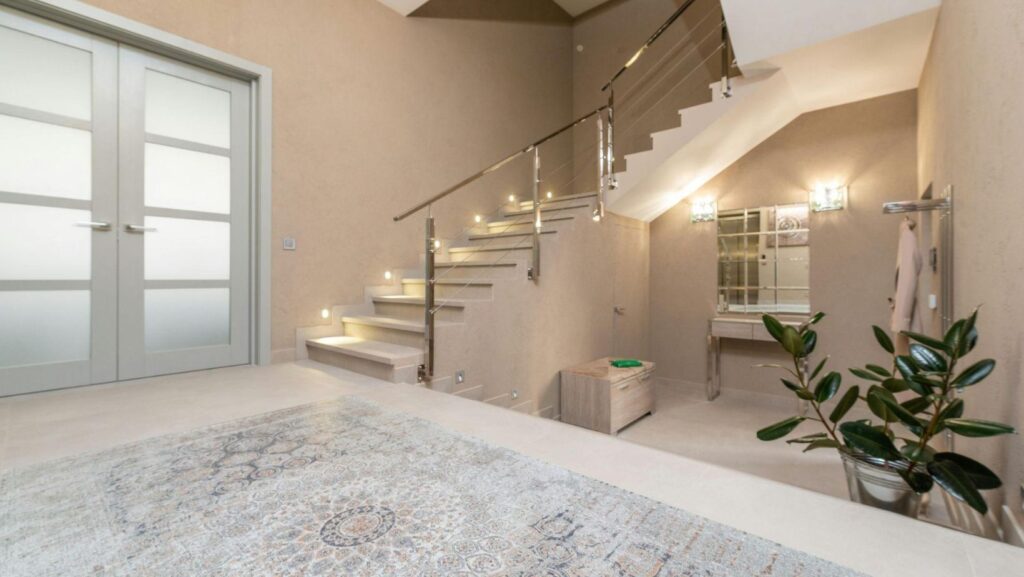
Creating an accessible home for wheelchair users goes beyond just ensuring that doorways are wide enough or adding ramps. The design of an accessible home should focus on promoting independence, comfort, and mobility throughout the entire living space. Whether you’re planning a renovation or building a new home, it’s essential to incorporate features that make everyday life easier for wheelchair users.
Wide Hallways and Doorways
One of the most important features of an accessible home is the width of hallways and doorways. Standard doorways are often too narrow for wheelchair access, making navigation difficult and frustrating. Ideally, doorways should be at least 36 inches wide to accommodate most wheelchairs comfortably. Similarly, hallways should allow for easy movements and turns, especially in homes with tight spaces or corners. This design aspect is crucial for avoiding unnecessary strain or accidents.
Door handles should also be considered. Lever-style handles are much easier for wheelchair users to operate than traditional round knobs, as they require less strength and dexterity. These small adjustments can make a significant difference in accessibility.
Ramps and Accessible Entrances
Accessible entrances are a must for wheelchair users. Stairs and raised door thresholds can be serious obstacles, so installing a ramp is essential. When constructing a ramp, it’s important to follow guidelines that ensure safety and ease of use. A good rule of thumb is a one-inch rise for every foot of ramp length. This gentle slope helps ensure that the ramp is manageable without being overly steep.
In addition to ramps, smooth transitions between indoor and outdoor spaces are vital. Thresholds should be as low as possible or non-existent, which prevents a wheelchair from getting caught. Automatic door openers can further enhance accessibility, making it easier to move freely in and out of the home.
Bathroom Modifications
The bathroom is one of the most critical areas to adapt for wheelchair accessibility. Start by ensuring that the door is wide enough and opens outward, leaving space inside for maneuvering. The layout of the bathroom should prioritize open space around essential fixtures like the sink, toilet, and shower.

Roll-in showers are highly recommended for wheelchair users. These showers are designed without barriers, allowing easy entry and exit. Adding a shower seat and grab bars can further improve comfort and safety. The sink should be mounted at a height that is accessible from a seated position, with enough clearance beneath it for a wheelchair to roll up close.
Toilet height is another important consideration. Higher toilets make it easier for users to transfer from a wheelchair, reducing the strain on their bodies. Grab bars near the toilet and shower also provide stability and support, which is essential for maintaining balance while transitioning between surfaces.
Kitchen Adjustments for Accessibility
The kitchen is often the heart of the home, but it can present many challenges for wheelchair users. Accessible kitchen design should emphasize reachable storage, easy-to-use appliances, and sufficient floor space. Cabinets should be installed lower, or pull-out shelving can be incorporated to make items more accessible. Installing an oven with side-opening doors and using pull-down shelves can also increase independence.
Countertops and sinks should be adjusted to an appropriate height, and it’s important to leave open space underneath so that a wheelchair can roll up easily. Appliances like dishwashers should have front controls, and refrigerators should be designed with easy access in mind, such as side-by-side models.
Stair Lifts and Elevators
For multi-story homes, accessing different levels can be one of the most challenging aspects for wheelchair users. Stair lifts or home elevators can provide a practical solution, making it possible to move between floors without assistance. Stair lifts can be installed alongside existing staircases, offering a seated option for those who can transfer from their wheelchair. However, for individuals who need to remain in their wheelchairs, an elevator is a more suitable choice. You should know that a home lift company can offer customized options based on the layout of the home and the specific needs of the user. Whether it’s a small personal lift or a full home elevator, these installations can significantly improve mobility, enabling wheelchair users to access all areas of their homes without limitations.
Lighting and Smart Home Features
Adequate lighting is often overlooked but plays a crucial role in home accessibility. Bright, evenly distributed lighting reduces the risk of accidents and makes navigation easier. In areas like hallways, bathrooms, and kitchens, motion-sensor lights can be a practical addition, allowing wheelchair users to move through the home without having to manually turn the lights on or off.

Smart home technology can further enhance accessibility. Voice-activated systems can control lighting, thermostats, and even security features, offering more independence to those with mobility challenges. Automated blinds, smart locks, and home intercom systems are just a few of the innovations that can be integrated into an accessible home to improve the quality of life.
Flooring Choices
The type of flooring in an accessible home also matters. Thick carpets and rugs can create obstacles, making it harder for wheelchairs to move smoothly. Ideally, floors should be hard and level, with materials like hardwood, laminate, or tile being excellent choices. These surfaces allow for easy navigation and reduce the risk of tripping or getting stuck.
Low-pile carpets can be an alternative if a softer surface is preferred, but make sure it’s firmly attached and doesn’t cause any resistance to wheelchair movement. Anti-slip coatings can also be applied to ensure safety, particularly in areas that may get wet, such as bathrooms or entryways.
Designing a home for accessibility is about creating a space that promotes independence and dignity. By incorporating features like wider doorways, ramps, accessible kitchens, and home elevators, wheelchair users can enjoy a living environment that meets their unique needs. Thoughtful design choices not only improve mobility but also enhance overall comfort and safety within the home.



